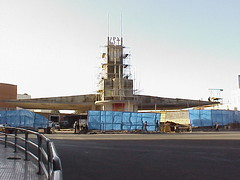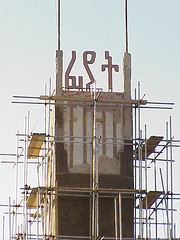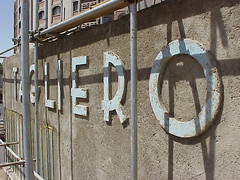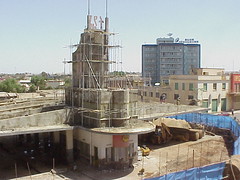 I was pleased to see that this article on www.eritreadaily.net included a picture of the fully restored Fiat Tagliero building in Asmara.
I was pleased to see that this article on www.eritreadaily.net included a picture of the fully restored Fiat Tagliero building in Asmara.
When I visited Asmara in April 2003, the building was surrounded by a blue temporary fence and covered in scaffolding. I was initially disappointed since this is one of Asmara’s most famous buildings and the one I most wanted to see.  The building was designed by Italian architect Giuseppe Pettazzi and built in 1938 when Eritrea was a firmly established Italian colony. It might look like an aeroplane complete with glass cockpit and wings but it was and still is a Service Station. The huge cantilevered concrete wings have no supporting columns. They are reinforced from above by a series of concrete ribs but are otherwise unsupported.
The building was designed by Italian architect Giuseppe Pettazzi and built in 1938 when Eritrea was a firmly established Italian colony. It might look like an aeroplane complete with glass cockpit and wings but it was and still is a Service Station. The huge cantilevered concrete wings have no supporting columns. They are reinforced from above by a series of concrete ribs but are otherwise unsupported.
Denison, Yu Ren & Gebremedhin report in their wonderful book Asmara: Africa's Secret Modernist City that the architect Pettazzi had to include pillars propping up the wings as some people did not believe the structural soundness of the structure. The pillars were made of wood when the building was opened it is alleged that Pettazzi put a gun to the builder's head to force him to remove the pillars. The wings held and we have this wonderful structure.
The lettering on top of the tower is Tigrinya local Eritrean languages. I love the shapes of the lettering but I have no clue what it says. I mentioned my initial disappointment of seeing the building surrounded by scaffolding but it worked to my advantage when our small group stuck our heads into the tower and seeing a spiral staircase we gestured that we might climb onto the wing. A simple nod was all it took for us to be up the staircase and out the narrow yellow door.
I mentioned my initial disappointment of seeing the building surrounded by scaffolding but it worked to my advantage when our small group stuck our heads into the tower and seeing a spiral staircase we gestured that we might climb onto the wing. A simple nod was all it took for us to be up the staircase and out the narrow yellow door.
The workers were a bit surprised to see us but posed for a photo. They thought we were mad to have travelled all the way from Australia to see a bunch of buildings. I’m not sure they aren’t correct but we established a bit of a rapport and they shouted a hasty warning if they were about to pour a fresh batch of concrete on us.  I walked up one of the concrete ribs to get this shot of the Tagliero lettering. It is one of my favourites even with the scaffolding and the shadows. I’m still shake my head when I see pictures of the Fiat Tagliero building when I think that I’ve walked on those wings. I can assure you that Guiseppe Pettazzi was correct with his structural engineering they feel as solid as a rock.
I walked up one of the concrete ribs to get this shot of the Tagliero lettering. It is one of my favourites even with the scaffolding and the shadows. I’m still shake my head when I see pictures of the Fiat Tagliero building when I think that I’ve walked on those wings. I can assure you that Guiseppe Pettazzi was correct with his structural engineering they feel as solid as a rock.
After we had reluctantly come back down to earth both physically and metaphorically I noticed a man sitting at the window of a nearby building looking down at us laughing. I signalled could we come up to his office and take some pictures. He glanced around nervously before nodding. As I’ve said, we didn’t need much encouragement and quickly counted off the floors and headed for the lifts. We were greeted by the staff of the local office of the German company Siemens who invited us in. They thought we were mad until we showed them the pictures of Asmara in our Lonely Planet Guidebook
We were greeted by the staff of the local office of the German company Siemens who invited us in. They thought we were mad until we showed them the pictures of Asmara in our Lonely Planet Guidebookand even then I think some of them were not too sure. But they took us out onto their terrace giving us perfect views of those amazing concrete wings.
Sometimes I do think we were mad to go to Asmara but only for a split second because it was one of the best experiences of my life. The buildings were fabulous. The people were charming. The sun shone everyday we were there and you could get a pizza, a cappuccino or a beer on just about every corner.
Reference:
Asmara: Africa's Secret Modernist City~ Edward Denison, Guang Yu Ren & Naigzy Gebremedhim
Friday, April 18, 2008
Fiat Tagliero Building, Asmara
Subscribe to:
Post Comments (Atom)






































.jpg)















The lettering spells out the name of the building "Fiat" in Tigrinya :)
ReplyDeleteThanks for the additional information.
ReplyDelete